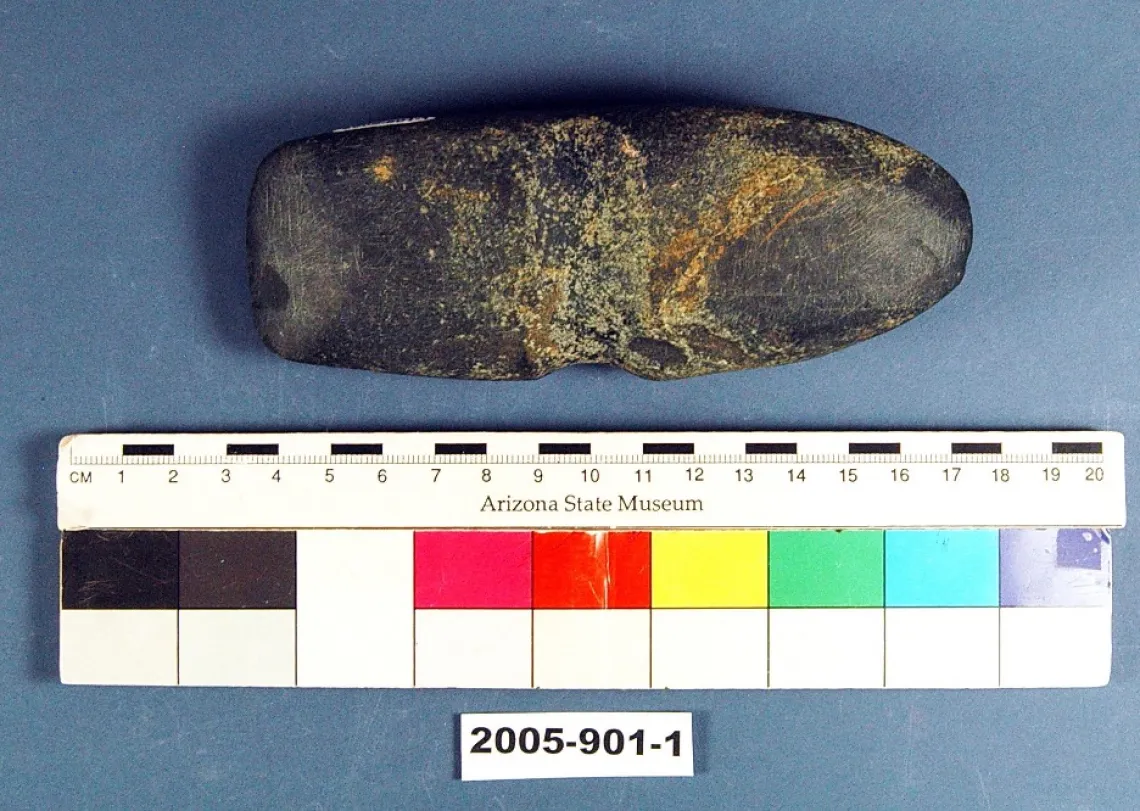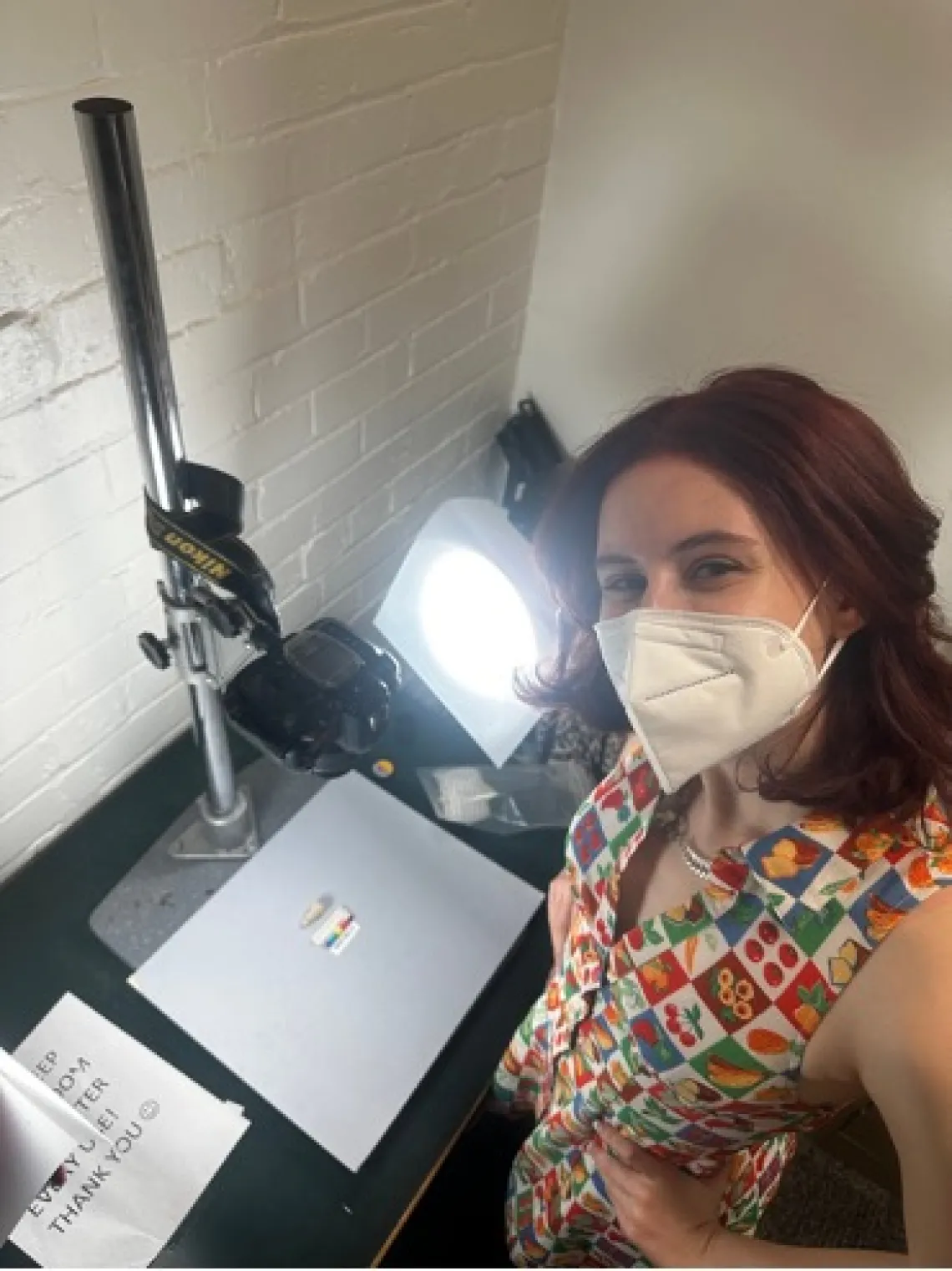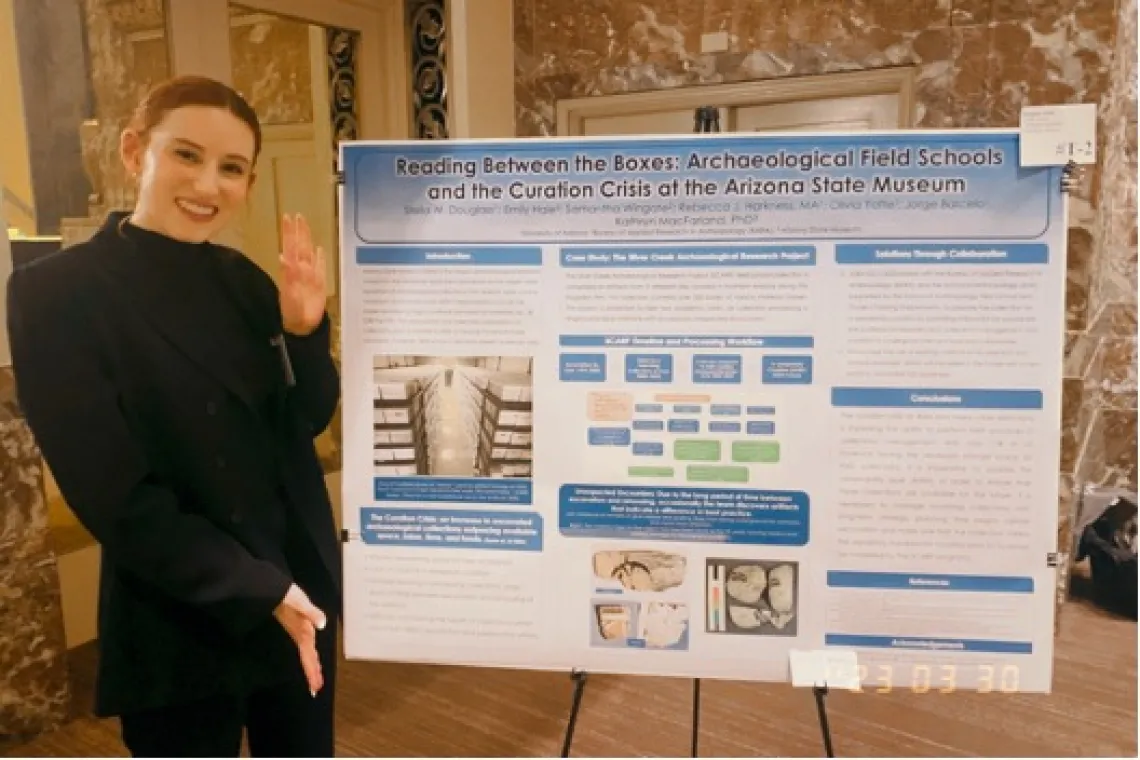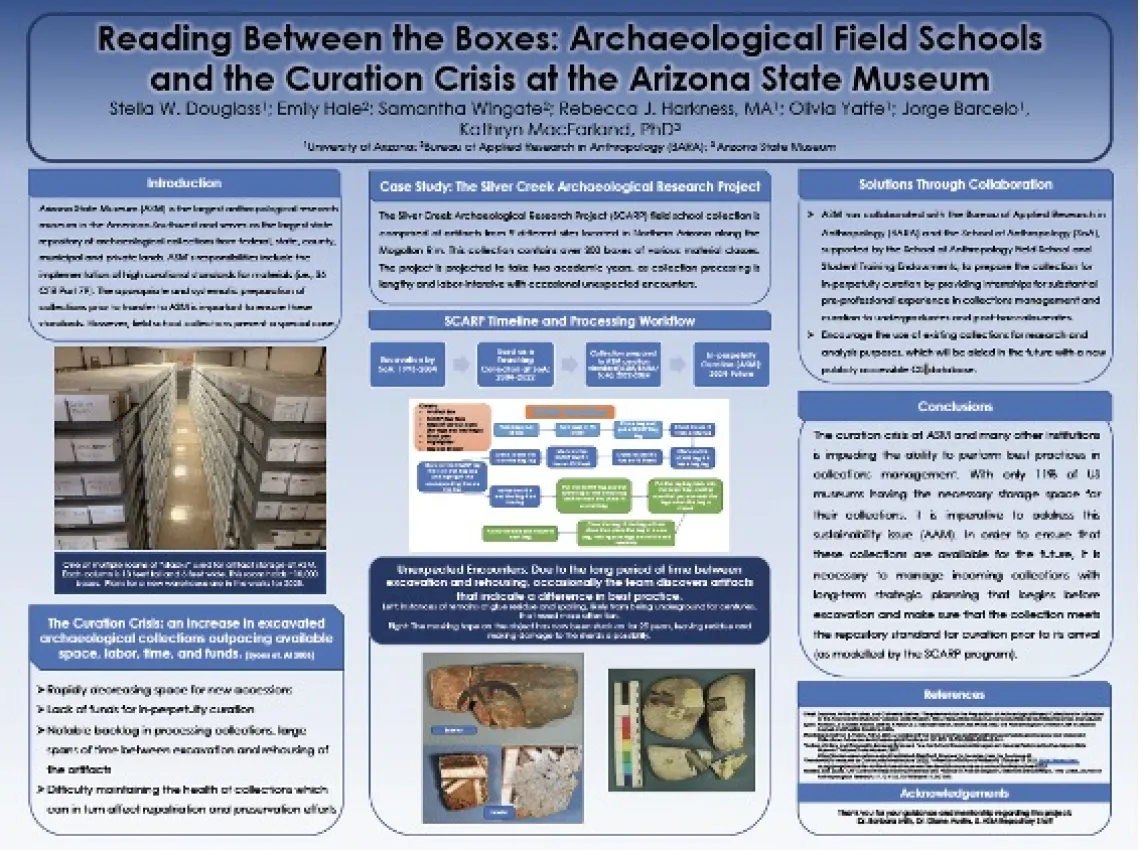
Figure 1: 2005-901-1: A double-bitted three quarters grooved axe from the Bailey Ruin SCARP, AZ P:1:11(ASM), site in northern Arizona.
By Stella Douglass, ASM Archaeological Repository and School of Anthropology BARA Intern
Spring 2023
Spring 2023 marks my third and final semester in the Arizona State Museum (ASM) Archaeological Repository as an intern, as I plan to graduate in May with a Bachelor’s in Art History with a minor in Arts Administration. I dipped my toe into the fields of Anthropology and Archaeology last year on the University Indian Ruin (UIR) collection, AZ BB:9:33(ASM), during which I was able to be a part of the artifact cataloging process. This school year I was assigned to the Silver Creek Archaeological Research Project (SCARP) in which I have been similarly involved with both the bulk and catalog portions of the collection. I have continued to attend meetings with the Bureau of Applied Research in Anthropology (BARA), and in March 2023, I was able to attend the Annual Meeting for the Society for Applied Anthropology in Cincinnati, Ohio. My time here has been busy, to say the least.
As this chapter of my time at ASM comes to a close (for now) I would like to reflect on my experience as an intern and what I learned, what I will carry forward, and how this work has related to my current area of interest. If I were to list some of the most useful and surprising elements of this internship it would go like this:
- Your database is only useful if your data is consistent and accurate; so don’t forget to check and recheck your data entries.
- Repository work is almost never static.
- I have a particular affinity for three-quarter grooved axes.
- The process of taking and editing photographs of artifacts.
- The repository has tons of opportunities to learn something new, keep your eyes and ears peeled as to what people are doing around you.
The bulk of my time as an intern was spent working with the database as we strove to enter SCARP bulk and catalog collections into Microsoft Access. This work was beneficial in that I have learned much more about relational database software, understanding the process of entering and extracting data from the database, and ultimately the importance of checking and rechecking your entered data. The data entered will need to be used by those around me and those who come after me, making it necessary to ensure that the provenience data matches the reports and bag lists. This leads into my second point: Repository work is almost never static. Even when doing bag checks and data entry, you might find information that doesn’t match your expectations, necessitating impromptu scavenger hunts for data verification. Sometimes, the Repository staff give workshops on important skills, like labeling artifacts. Just when you think you have a system down pat, some new element comes up, prompting the team to problem solve. And, sometimes, you find yourself with a really awesome artifact on your hands (Figure 1).

Figure 2: Stella Douglass in the process of photographing an artifact from the Silver Creek Anthropological Research Project catalog collection.
This axe (2005-901-1) has been worked on both edges and grooved in the center. This is the first double-bitted axe I have seen, so this was particularly exciting for me. I had developed a soft spot for axes last year while working on UIR, where my favorite object from that catalog collection was another three-quarter grooved axe. Not to mention, this axe was found in situ with another axe (2005-901-3) and an axe blank (2005-901-2), as well as several other artifacts, indicating possible de facto refuse (Mills et al. 1999).
My favorite part of the cataloging process, by far, is photographing the artifacts and later editing the photos (Figure 2). This process requires staging the artifact under the camera, choosing a background color, adjusting the lighting, and ensuring that your photo is in focus and clear. Editing these photos involves a certain amount of creativity, and it is exciting to know that those who are not physically able to be in the Repository might see your photo when looking at this particular artifact.

Figure 3: Stella Douglass standing with poster at the SfAA student poster session.
This semester I also had the opportunity to go to the Annual Meeting for the Society of Applied Anthropology (SfAA). The SCARP team and I collaborated on a poster entitled Reading Between the Boxes: Archaeological Field Schools and the Curation Crisis at the Arizona State Museum, which was awarded as an honorable mention for the Valene Smith prize (Figures 3 and 4). While at the conference I attended some fantastic presentations and was greatly inspired by the scope of the work being done currently in applied anthropology. It also struck me that while I had largely considered my major and research interests to be separate from what I was doing at ASM and as a BARA intern, they really were not so different at all. I have benefitted from an interdisciplinary education as both an art historian and a human being.

Figure 4: A poster made from a collaboration of the SCARP team, presented in Cincinnati, Ohio at the SfAA’s in March of 2023.
As I mentioned previously, my background is in Art History, and to be more specific, I am largely interested in contemporary feminist and queer art. As you might imagine, this is a far cry from ancient Native American artifacts and architecture of the Southwest region. When beginning to reflect on my experience at the Repository, I was thinking about the connections between my work in collections management and my art historical research. I am currently researching the database of the University of Arizona Museum of Art (UAMA) and the way LGBTQ+ art and artists are cataloged. Between my work at ASM and UAMA, I have been considering what it means to input information about works into data that typically falls under a strict binary. For LGBTQ+ art and artists, this can be harmful as it flattens their experience into categories that these objects and persons exist outside of. But, it is difficult because data needs to be collected and cataloged for provenance purposes. Within my research, I am interested in ways of upending or disrupting the database to move away from a strict, binary system that positions itself as neutral or normative. I certainly don’t have the answer, but it is an area that I have been challenging myself to consider while working on both projects.
Additionally, I found it incredibly helpful to discuss the various projects happening within the Bureau of Research in Applied Anthropology at our meetings and being exposed to the various methodologies such as participant observation, field notes, data coding and more. As I go onto graduate school in the fall at the Courtauld Institute of Art, I will bring with me the importance of an interdisciplinary approach to research and museum work. In the future I plan to pursue work within collections management as I have loved the experience of handling the objects as well as the catalog process. I also hope to improve my skills working with Microsoft Access so that in the future I might be able to design a database, rather than just input the data. I am sad to be leaving the ASM Repository, as it has been a place full of positive learning experiences and exciting opportunities for me. I feel very grateful to have worked with such a great team, both on UIR and SCARP, and also to have learned so much from Dr. MacFarland, Dr. Austin, Dr. Dungan, Dr. Mills, the Repository staff, and my fellow BARA interns.
References:
Mills, Barbara J, Sarah A. Herr, and Scott Van Keuren (editors) 1999 Living on the Edge of the Rim: Excavations and Analysis of the Silver Creek Archaeological Research Project, 1993-1998. Arizona State Museum Archeological Series 192 Vols. 1-2. Tucson, AZ.





